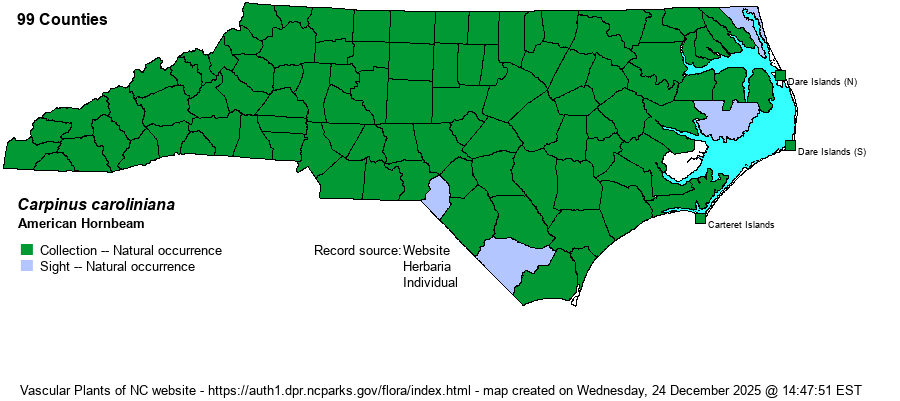| Author | Walter | |
| Distribution | Occurs throughout the state, undoubtedly present in all 100 counties.
This is a species that ranges across the entire Eastern U.S. and southern Canada. It ranges to central FL to eastern TX.
| |
| Abundance | Common to abundant across the entire state, probably less numerous (common) in the Mountains owing simply to less habitat there than downstate. Also mostly uncommon in counties near the coast. | |
| Habitat | This is a species primarily of bottomlands, drier parts of swamps, stream banks, and other areas close to water. It does occur in uplands, but generally only in richer soil on the lower slopes of moist forests, such as cove forests. |
| Phenology | Flowers in March and April, and fruits in September and October. | |
| Identification | This is a small deciduous tree that normally reaches about 30-35 feet tall and is often much broader than tall. It has a distinctive trunk: smooth gray bark that is fluted or “muscular”, with a sinewy look of curving but somewhat vertical ridges and “valleys”. The leaves are fairly narrowly elliptic to slightly ovate, with serrated margins, growing to about 3 inches long. If the leaves or trunk are not conclusive enough, then the odd fruit in late summer and fall will be. The fruit is a dangling cluster of several green and leafy bracts (each enclosing a small nut) that resemble the fruit of no other species in our area. The leaves might be confused a bit with the closely related Ostrya virginiana, whose leaves are a bit wider; however, the bark and the fruit are very different. | |
| Taxonomic Comments | Recent taxonomic work suggests that there are two varieties; C. caroliniana var. caroliniana of the Coastal Plain and into the Piedmont, and C. caroliniana var. virginiana of the mountains and most of the Piedmont. NatureServe has these two entities listed as subspecies instead of varieties.
| |
| Other Common Name(s) | Most recent references now use the name of American Hornbeam. However, some (especially older ones) also use Blue Beech or Musclewood. Many also use Ironwood, but that name is also used for the related Ostrya virginiana and thus becomes a very confusing name. | |
| State Rank | S5 | |
| Global Rank | G5 | |
| State Status | | |
| US Status | | |
| USACE-agcp | FAC link |
| USACE-emp | FAC link |

